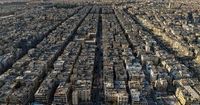On October 21, 2025, the World Bank released a sobering assessment of Syria’s post-war reality: rebuilding the war-torn nation will require an estimated $216 billion—nearly ten times the country’s projected gross domestic product for 2024. The staggering figure, detailed in the Syria Physical Damage and Reconstruction Assessment 2011-2024, underscores just how deep the scars of over thirteen years of conflict run, both for the country’s infrastructure and its people.
The Syrian civil war, which erupted in 2011 after President Bashar al-Assad’s brutal crackdown on mass protests, spiraled into a devastating conflict that left over half a million dead and displaced millions. The violence gutted entire neighborhoods, destroyed hospitals, schools, and factories, and battered critical infrastructure such as the electrical grid. According to AP and NDTV, the war’s end came in December 2025 with Assad’s ouster in a swift rebel offensive, ushering in a new era of Islamist-led governance.
The World Bank’s report paints a grim picture: nearly one-third of Syria’s pre-war capital stock has been damaged or destroyed. Direct physical damages to infrastructure, residential buildings, and non-residential structures are estimated at $108 billion. Of this, infrastructure bore the brunt—accounting for 48 percent of the total, or $52 billion. Residential buildings suffered $33 billion in damage, and non-residential structures such as factories and public buildings accounted for another $23 billion. The overall projected reconstruction expenses, which could range from $140 billion to $345 billion, settle at a conservative best estimate of $216 billion.
Breaking down the costs further, the World Bank estimates that $82 billion will be needed just to rebuild infrastructure, $75 billion for residential buildings, and $59 billion for non-residential structures. The provinces of Aleppo and Rif Dimashq (the Damascus countryside) suffered the most severe destruction and will require the largest investment. As Economic Times and NDTV note, these areas were major rebel strongholds and saw some of the fiercest fighting and bombardment during the early years of the war.
“The challenges ahead are immense, but the World Bank stands ready to work alongside the Syrian people and the international community to support recovery and reconstruction,” said Jean-Christophe Carret, World Bank Middle East Division director, in a statement quoted by multiple outlets. He emphasized the need for “collective commitment, coordinated action, and a comprehensive, structured support program” to help Syria recover and build a more resilient future.
Yet the numbers only tell part of the story. The war’s economic toll has been catastrophic. Syria’s real GDP has plunged by almost 53 percent from 2010 to 2022, according to the Syria Macro-Fiscal Assessment. In nominal terms, GDP fell from $67.5 billion in 2011 to an estimated $21.4 billion in 2024. Unsurprisingly, the United Nations estimates that 90 percent of Syrians now live in poverty. Cuts to international aid have only deepened hardship for ordinary Syrians, leaving many without access to basic services or reliable income.
Despite the enormity of the task, there are glimmers of hope. Since Assad’s removal, Syria’s new authorities have worked to reestablish diplomatic ties with Western nations and have signed investment deals worth billions with Gulf countries. Saudi Arabia, for instance, recently committed a strategic crude oil grant of 1.65 million barrels, a move that could help ease the country’s acute energy shortages and support reconstruction efforts. This grant is part of broader humanitarian and economic assistance, reflecting a growing willingness among regional powers to engage pragmatically with Syria’s recovery, even as political differences linger.
Diplomatic initiatives have also gained traction, with Egypt playing a key role in facilitating dialogue between Syrian authorities and regional stakeholders. These efforts have cautiously opened new avenues for cooperation and investment, though the overall security situation remains volatile and access for international aid organizations is still limited in many regions.
Still, the path to rebuilding is riddled with challenges that go far beyond raising funds. The World Bank’s assessment, conducted with support from the Global Facility for Disaster Reduction and Recovery, acknowledges significant methodological uncertainties due to the prolonged conflict and patchy data. The report deliberately avoids detailed breakdowns by sector or asset type, aiming instead to provide a broad estimate to inform recovery planning and spark international dialogue.
Transparency and accountability are at the forefront of donor concerns. International financial institutions and donor countries have stressed the need for robust governance frameworks to ensure reconstruction funds are managed effectively and reach their intended projects. Without such safeguards, there is a risk that much-needed aid could be diverted or lost to corruption—an all-too-familiar problem in post-conflict settings.
Moreover, experts and international agencies are increasingly advocating for a holistic, community-centered approach to rebuilding. It’s not just about bricks and mortar. Restoring social services such as healthcare, education, and water supplies is essential for stabilizing communities and fostering economic revival. There’s also a growing emphasis on integrating digital technologies and sustainability principles into reconstruction plans, with the aim of creating infrastructure that’s more resilient to future shocks—whether natural or man-made.
“This report provides a critical baseline of the massive scale of the destruction and of the reconstruction costs ahead,” said Syria’s Finance Minister, Mohammed Barnieh, as reported by NDTV. “Now, more than ever, it is imperative for the international community to mobilize support and partnership to help Syria restore essential infrastructure, revitalize communities, and lay the foundation for a more resilient future for its people.”
For ordinary Syrians, however, the reality remains harsh. Despite the lifting of many Western sanctions imposed during the Assad dynasty, the impact on the ground has been limited. The country’s battered economy, coupled with cuts to international aid, means that daily life for most Syrians is still defined by scarcity and uncertainty. As the World Bank and United Nations figures make clear, the overwhelming majority of the population struggles to meet basic needs—a stark reminder that reconstruction is not just a technical or financial challenge, but a deeply human one.
As Syria stands at this crossroads, the world faces a profound test: will the global community step up to help rebuild a nation shattered by war, or will Syria’s future be left to chance and the vagaries of regional politics? The answer, for now, remains uncertain, but the need for action has never been more urgent.




